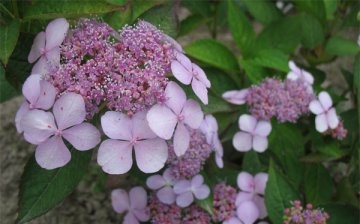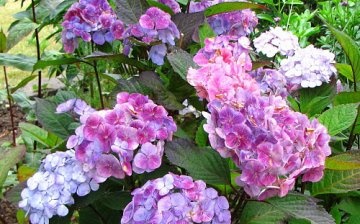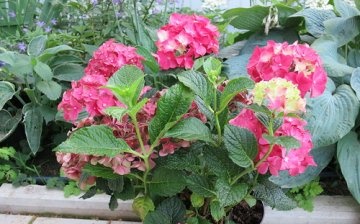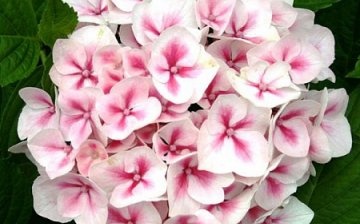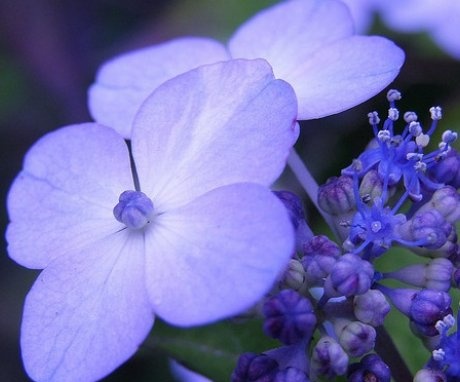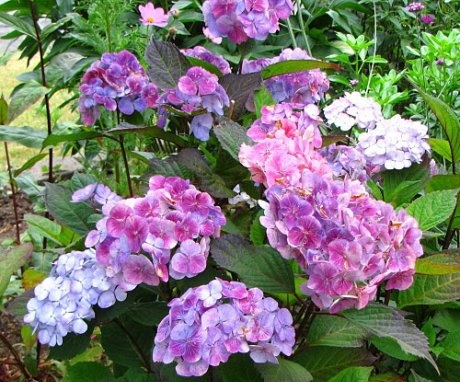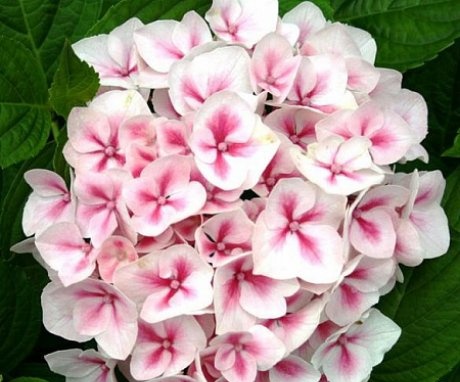Serrated hydrangea: types, planting and care
Treelike shrubs of extraordinary beauty with bright greenery and spectacular flower heads are hydrangea. Able to decorate any area and give it a special flavor. The birthplace of hydrangea is Japan. The plant got to Europe in the 20s of the 19th century. Heat-loving and moisture-loving, it has long been considered an indoor or greenhouse plant.
Description
- Hydrangea serrated Bluebird
- Hydrangea serrata Preciosa
- Planting and care of serrata hydrangea
- Tips for growing hydrangeas
Hydrangea serrated Bluebird
Hydrangea serrata is a spreading plant about one and a half meters high. The foliage is green, with an elliptical leaf, with jagged edges. The ability to change the color of inflorescences depends on the acidity of the soil. Shades range from blue to pale pink and lilac. Unusually good in July-August during flowering. On the edges of the inflorescence - large white flowers with a blue center, which gradually change color to pink.
Prefers nutritious slightly acidic and acidic soils with good drainage system and illuminated places.
It also tolerates light partial shade. For abundant annual flowering, a mandatory shelter for the winter is required. As a shelter, it is recommended to wrap the bush in burlap, roofing felt and be sure to sprinkle it inside with dry leaves. That is why serrata hydrangea is grown mainly in the southern regions, in the northern it is prone to freezing.
Bluebird salient features:
- A sprawling shrub with blue and purple flowers, used for individual or group plantings in parks, courtyards and garden plots.
- Inflorescences are very beautiful - flat, about 10 cm in diameter, with a floating color: in the middle they are pink-purple with blue stamens, along the edges - from light purple to bright blue, 2-3 cm in size (the flowers are light blue if the shrub grows on acidic soils). Blooms profusely from late July to late September. Young plants also bloom profusely.
- Good grows on fertilized acidic soils, requires abundant watering. The landing site must be protected from winds and drafts. The shrub is not frost-hardy; shelter for the winter is necessary.
Decorating your plot with such a shrub will be an indicator of his skills and knowledge for any gardener. Only those who know how hard it is to preserve this plant will be able to appreciate this.
Hydrangea serrata Preciosa
Another shrub belonging to the genus Hydrangea serrata:
- A beautiful, dense, compact plant 100-120 cm high.
- The flowers are collected in thick caps, first yellowish-green, then pink, and by autumn crimson-red.
- The diameter of the inflorescences is about 12 cm. The acidity of the soil does not affect the color of the flowers.
- Sometimes the inflorescences contain both fruiting flowers (in the center) and barren flowers (along the edges), but not always.
- There are options when there are only barren flowers in the inflorescence.
- Planting requires a sunny or partial shade location with well-drained nutrient soil.
Hydrangea Preciosa is a winter-hardy shrub that can withstand frosts down to -23 degrees.
For the winter, it is recommended to bend the branches to the ground and close them with spunbond. This cover should be enough. Many gardeners claim that this type of hydrangea they winters without shelter at all and at the same time blooms beautifully in summer. Perhaps it is so. But in temperate regions, it probably makes no sense to take risks.
Planting and care of serrata hydrangea
As already mentioned, for planting serrata hydrangea bushes, you need to choose a sunny, quiet place, protected from drafts. The soils are acidic, drained.
Multiply recommended by cuttings:
- This is the main way they reproduce, although cuttings and seeds can be used.
- In order to get good planting material, it is not bad to have a so-called mother bush on the site.
- They are purchased in nurseries for a 100% guarantee of variety confirmation.
- For summer cuttings, take branches with buds, remove the inflorescences and cut them so that they have one or two internodes, 4-5 cm long is enough.
- The lower cut is made oblique, the upper cut is straight, immediately after the upper knot.
- The 2 pairs of leaves left on the handle are cut off by one third or half.
- Thus, the evaporating surface is reduced (remember that the plant is moisture-loving).
- The prepared cuttings are treated with heteroauxin, then planted in the soil to a depth of 1 cm.
- Rooting is carried out at home, in greenhouses, and outdoors.
- The main thing is to close the planting material from direct sunlight.
- The main care for planted cuttings is timely, sufficient watering and spraying.
Hydrangea serrata is quite resistant to pests and diseases, but can be affected by false powdery mildew and chlorosis. Chlorosis affects bushes growing on calcareous and too humus-fertilized soils. With the disease, the leaves become lighter in color with obvious dark veins. To cure, the plant is spilled 2-3 times with a solution of potassium nitrate (nitrate, who does not know) at the rate of 40 grams per 10 liters of water, then after three days it is treated with a solution of copper sulfate, also in a proportion of 40 grams of powder per 10 liters of water.
In case of a downy mildew disease, oily spots appear on the stems and leaves, which subsequently darken and increase in size.
A characteristic yellowish bloom appears on the seamy side of the leaves. The affected bushes are treated with the composition: 15 grams of copper and vitriol and 150 grams of green soap per bucket of water.
Tips for growing hydrangeas
It is recommended to rejuvenate the bushes every 2-3 years, while old branches and trunks are cut out.
There are two types of plant pruning:
- With a strong pruning, twigs with 2-3 buds are left, the inflorescences are large, but they will become smaller.
- If it is weak, the tops of the shoots with 2 or 3 buds are subject to removal, as a result, many small inflorescences.
If, during the period of bud formation, water the plant with a slightly colored solution of potassium permanganate, then the white flowers will turn pink.
To obtain inflorescences of blue-blue shades recommended twice a month pour a solution of potassium-aluminum alum under the bush - 3-5 grams per 1 liter of water.
To summarize: the plant loves watering and fertile acidic soils, it grows better in the sun or in light partial shade. It is better to cover for the winter - not only the roots, but also the bush itself.
Try to plant a serrated hydrangea in your area. And she will thank you for your care and patience with impossibly beautiful flowering.
More information can be found in the video.



